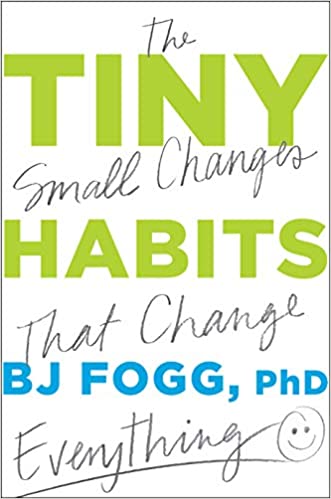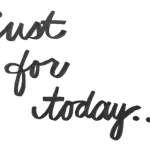“The essence of Tiny Habits is this: Take a behavior you want, make it tiny, find where it fits naturally in your life, and nurture its growth. If you want to create long-term change, it’s best to start small.”
Tiny Habits—created by Dr. BJ Fogg, a world-renowned Behavior Scientist at Stanford University—is based on 20 years of research and Dr. Fogg’s experience personally coaching over 40,000 people. Tiny Habits is a great book on the art of habit formation; in the past 12 months have been fascinated by the power of micro-habits and have been experimenting with getting things done using micro-habits. The tiny habits approach has been transformative in my quest to achieve goals such as 100 Books Reading Challenge, 100 Books Audiobook challenge, Project Python 2021, 5 Minute daily gratitude journaling.
There are only three things we can do that will create lasting change: Have an epiphany, change our environment, or change our habits in tiny ways
Brian Jeffrey Fogg is an American social scientist who is currently a research associate at Stanford University and an author. He is the founder and director of the Stanford Persuasive Technology Lab, later renamed as Behavior Design Lab,
Here are my Favourite Take-aways from reading, Tiny Habits by BJ Fogg:
In order to design successful habits and change your behaviors, you should do three things.
- Stop judging yourself.
- Take your aspirations and break them down into tiny behaviors.
- Embrace mistakes as discoveries and use them to move forward.
Imagine a big plant with small roots. When a powerful wind kicks up, the big plant might topple over because it’s not held firmly in place. And that’s how habit formation works. If you start with a big behavior that’s hard to do, the design is unstable; it’s like a large plant with shallow roots. When a storm comes into your life, your big habit is at risk. However, a habit that is easy to do can weather a storm like flexible sprouts, and it can then grow deeper and stronger roots.
So if you haven’t gotten off the couch in a year, don’t start with seven minutes of strenuous activity. Start tiny instead. Shore up the weakest link in your Ability Chain by making your new workout habit radically easy to do. Scale back to doing one wall push-up. Just one. When you run into a setback—a cold, for instance—you can still manage to do one wall push-up, stuffy nose and all. By going tiny, you create consistency; by staying tiny, you get your new habit firmly rooted.
Behavior Design: comprehensive system for thinking clearly about human behavior and for designing simple ways to transform your life.
TINY IS FAST
“Time. There’s never enough of it, and we always want more of it.”
We feel so pressed for time. This pressure leads to a scarcity mindset—we believe that there will never be enough time, so we say no to changes because we feel like we don’t have the hours to cultivate new positive habits.
With the Tiny Habits method, you focus on small actions that you can do in less than thirty seconds. You will quickly wire in new habits, and then they will grow naturally. Starting tiny means you can begin creating a big change without worrying about the time involved.
The more stressed you are and the less time you have, the more appropriate this method is for you. No matter how much you want to cultivate a healthy habit, you won’t be able to do it reliably if you start big. When you go big, the new habit probably won’t stick. In many people’s lives, tiny isn’t just the best option, it might be the only option.
The Maui Habit
After you put your feet on the floor in the morning, immediately say this phrase, “It’s going to be a great day.” As you say these seven words, try to feel optimistic and positive.
Think of the Maui Habit as a simple practice you do each morning in about three seconds. This will show you how easy it is to get started, and it will help you learn the single most important skill in behavior change—feeling successful.
TINY CAN GROW BIG
We live in an aspiration-driven culture that is rooted in instant gratification. We find it difficult to enact or even accept incremental progress. Which is exactly what you need to cultivate meaningful long-term change. People get frustrated and demoralized when things don’t happen quickly. It’s natural. It’s normal. But it’s another way we’re set up to fail.
One tiny action, one small bite, might feel insignificant at first, but it allows you to gain the momentum you need to ramp up to bigger challenges and faster progress. The next thing you know, you’ve eaten the whole whale.
TINY IS TRANSFORMATIVE
With the Tiny Habits method, you celebrate successes no matter how small they are. This is how we take advantage of our neurochemistry and quickly turn deliberate actions into automatic habits. Feeling successful helps us wire in new habits, and it motivates us to do more.
With Tiny Habits, you also learn how to feel good in your life. The ability to pat yourself on the back instead of beat yourself up grows solid, life-changing roots.
The ABC Anatomy of Tiny Habits
1. ANCHOR MOMENT
An existing routine (like brushing your teeth) or an event that happens (like a phone ringing). The Anchor Moment reminds you to do the new Tiny Behavior.
2. NEW TINY BEHAVIOR
A simple version of the new habit you want, such as flossing one tooth or doing two push-ups. You do the Tiny Behavior immediately after the Anchor Moment.
3. INSTANT CELEBRATION
Something you do to create positive emotions, such as saying, “I did a good job!” You celebrate immediately after doing the new Tiny Behavior.
“When you don’t know the answers, riddles seem hard to solve. But once you see the answer, the solution seems obvious.”
The Fogg Behavior Model
“You can change your life by changing your behaviors. You know that. But what you may not know is that only three variables drive those behaviors.”
BMAP
A behavior happens when the three elements of MAP—Motivation, Ability, and Prompt—come together at the same moment.
“Behaviors are like bicycles. They can look different, but the core mechanisms are the same. Wheels. Brakes. Pedals”
- Motivation is your desire to do the behavior.
- Ability is your capacity to do the behavior. And
- Prompt is your cue to do the behavior.
“Remember, for a behavior (B) to occur, three elements must converge at the same moment: Motivation, Ability, and Prompt.”
If you can’t change one component of the Behavior Model (motivation in this case), then you focus on changing the others (ability and prompt). Three Steps for Troubleshooting a Behavior
Try each step in order. If you don’t get results, move to the next step.
- Check to see if there’s a prompt to do the behavior.
- See if the person has the ability to do the behavior.
- See if the person is motivated to do the behavior.
. Motivation and ability work together like teammates
You need to have both motivation and ability for a behavior to land above the Action Line, but motivation and ability can work together like teammates. If one is weak, the other needs to be strong to get you above the curve. In other words: The amount you have of one affects the amount you need of the other. Understanding the relationship of motivation and ability opens the door to new ways of analyzing and designing behaviors. If you have only a little bit of one, then you need more of the other—i.e., they compensate each other.
“You can disrupt a behavior you don’t want by removing the prompt. This isn’t always easy, but removing the prompt is your best first move to stop a behavior from happening.”
The Motivation Monkey.
The Motivation Monkey tricks us into setting unreasonable goals. He can sometimes help us reach amazing heights, but he will often abandon us when we need him most. The Motivation Monkey’s traps are stealthy and numerous. They catch you whether you’re facing a big project or attempting to change your habits.
“Motivation is like a party-animal friend. Great for a night out, but not someone you would rely on to pick you up from the airport. You must understand its role and its limitations, then pick behaviors that don’t rely on such a fickle friend.”
Aspirations, Outcomes, and Behaviors.
Aspirations are abstract desires, like wanting your kids to succeed in school.
Outcomes are more measurable, like getting straight As second semester. Both of these are great places to start the process of Behavior Design.
But aspirations and outcomes are not behaviors.
A behavior is something you can do right now or at another specific point in time. You can turn off your phone. You can eat a carrot. You can open a textbook and read five pages. These are actions that you can do at any given moment.
In contrast, you can’t achieve an aspiration or outcome at any given moment. You cannot suddenly get better sleep. You cannot lose twelve pounds at dinner tonight. You can only achieve aspirations and outcomes over time if you execute the right specific behaviors.
Steps in Behavior Design
Step 1: Clarify the Aspiration
Step 2: Explore Behavior Options
Step 3: Match with Specific Behaviors
A Golden Behavior
A Golden Behavior can be a one-time action. Canceling your cable subscription is a task done one time that will probably lead to watching TV less. Other Golden Behaviors will be habits you repeat day after day, such as charging your phone in the kitchen instead of next to your bed.
Clarify your aspiration or outcome, generate a big set of behavior options, and match yourself with specific Golden Behaviors. That’s how you put Behavior Design into practice in your own life. And it’s also how you match yourself with the best habits for doing Tiny Habits.
Starter Step
This is exactly what it sounds like: one small move toward the desired behavior. If you want to make a habit out of walking three miles every day, your Starter Step might be putting your walking shoes on. That Starter Step becomes your Tiny Behavior and the only action you need to do at the start of your new habit. The objective here is to begin with a crucial step in the process of doing the desired behavior. Tell yourself: I don’t have to walk. I just have to make sure I put on my shoes each day.
Prompts
“Prompts are the cues that remind us to act. They are the spark that lights the fire“
We experience hundreds of prompts each day, yet we barely notice most of them. More often than not, we simply act. The stoplight turns green—you hit the gas. You’re offered a cheese sample at the grocery store—you eat it. A notification pops up on your computer screen letting you know you have a new e-mail—you click to open it. Some prompts exist naturally—you feel a few drops of rain on your arm so you open your umbrella. Some prompts are designed—the smoke alarm blares so you open a few windows and rescue that forgotten pizza in the oven. Whether natural or designed, a prompt says, “Do this behavior now”
Celebrate your tiny successes.
“Celebration Is the Bridge from Tiny Habits to Big Changes”
Celebrate your tiny successes. This one small shift in your life can have a massive impact even when you feel there is no way up or out of your situation. Celebration can be your lifeline.
Change is a process, just like growing a flower in the garden or healing a cut on your finger. And like any process, there are things we can do to optimize it—to speed things along and make course corrections along the way. By understanding how our habits grow and what our role is in the growth process, we can reliably design for the change—the transformation—we want in our life.
Breaking Bad Habits
A helpful way to think about habits is to put them into three categories. I’m talking about all habits here—good and bad.
- Uphill Habits are those that require ongoing attention to maintain but are easy to stop—getting out of bed when your alarm goes off, going to the gym, or meditating daily.
- Downhill Habits are easy to maintain but difficult to stop—hitting snooze, swearing, watching YouTube.
- Freefall Habits are those habits like substance abuse that can be extremely difficult to stop unless you have a safety net of professional help.
Like positive habits, bad habits exist on a continuum of easy to change and hard to change. When you get toward the “hard” end of the spectrum, note the language you hear—breaking bad habits and battling addiction. It’s as if an unwanted behavior is a nefarious villain to be aggressively defeated. But this kind of language (and the approaches it spawns) frames these challenges in a way that isn’t helpful or effective.
All the Best in your quest to get Better. Don’t Settle: Live with Passion.



2 Comments
Pingback: 100 Books Reading Challenge 2021 – Lanre Dahunsi
Pingback: 10 Strategies for achieving your New Years Resolution. | Lanre Dahunsi